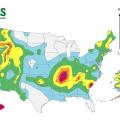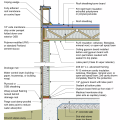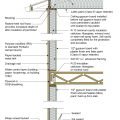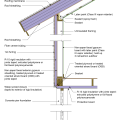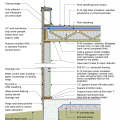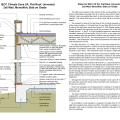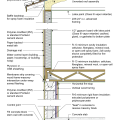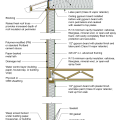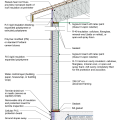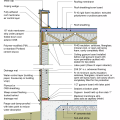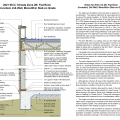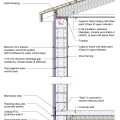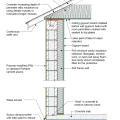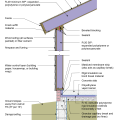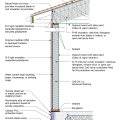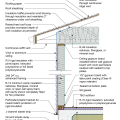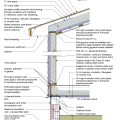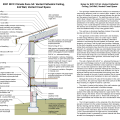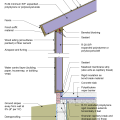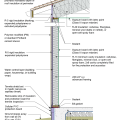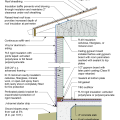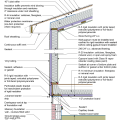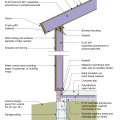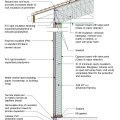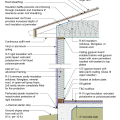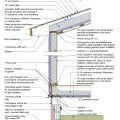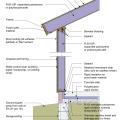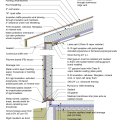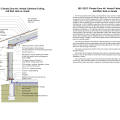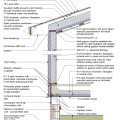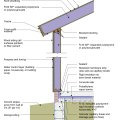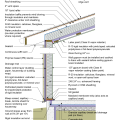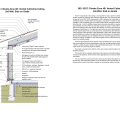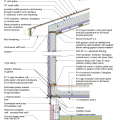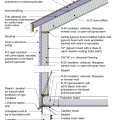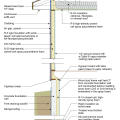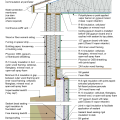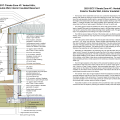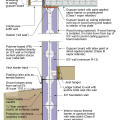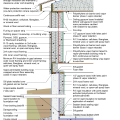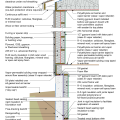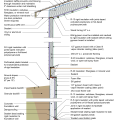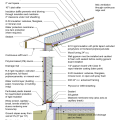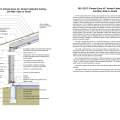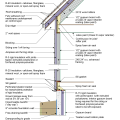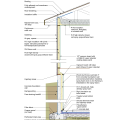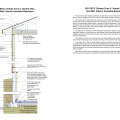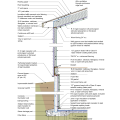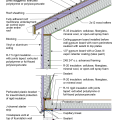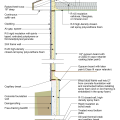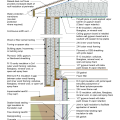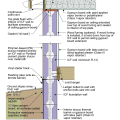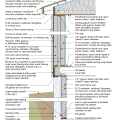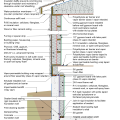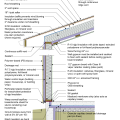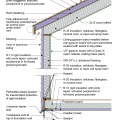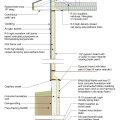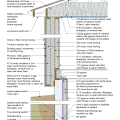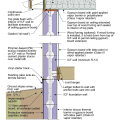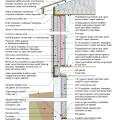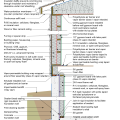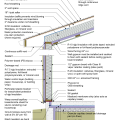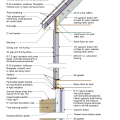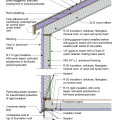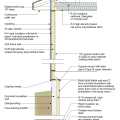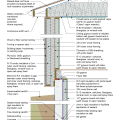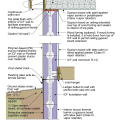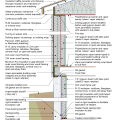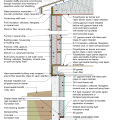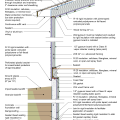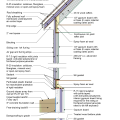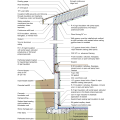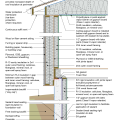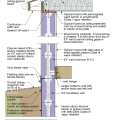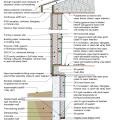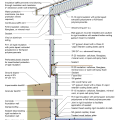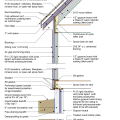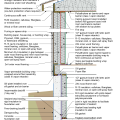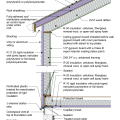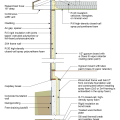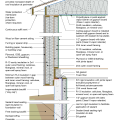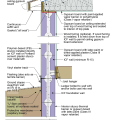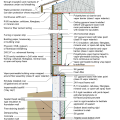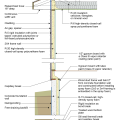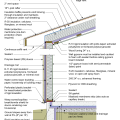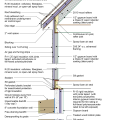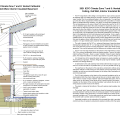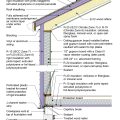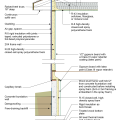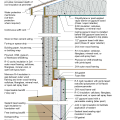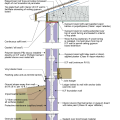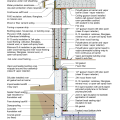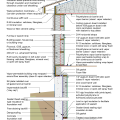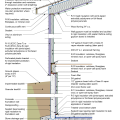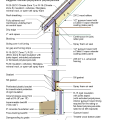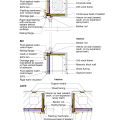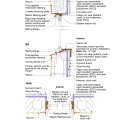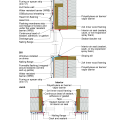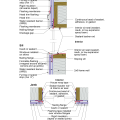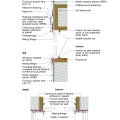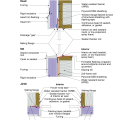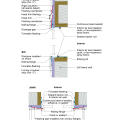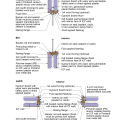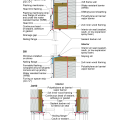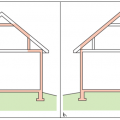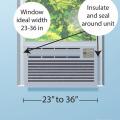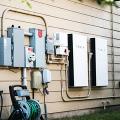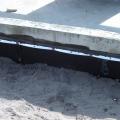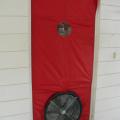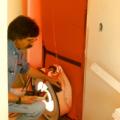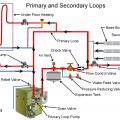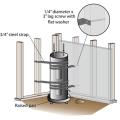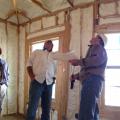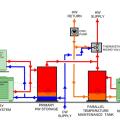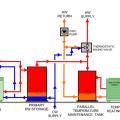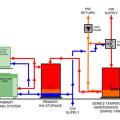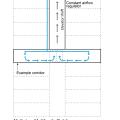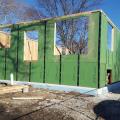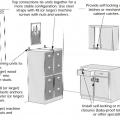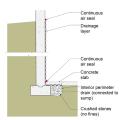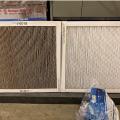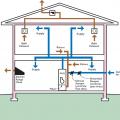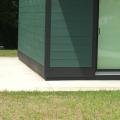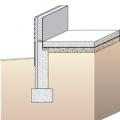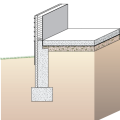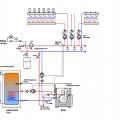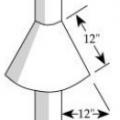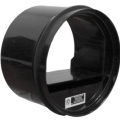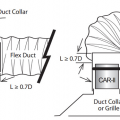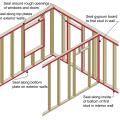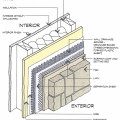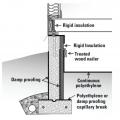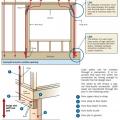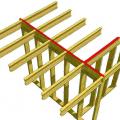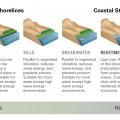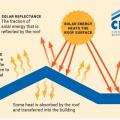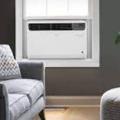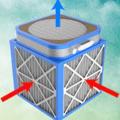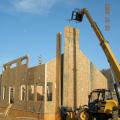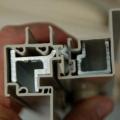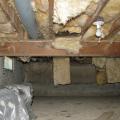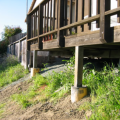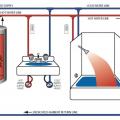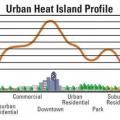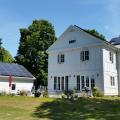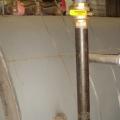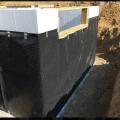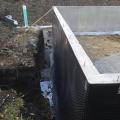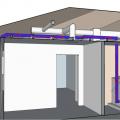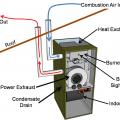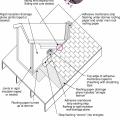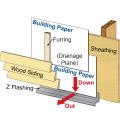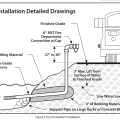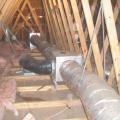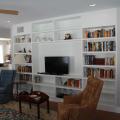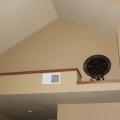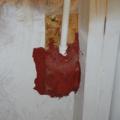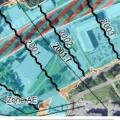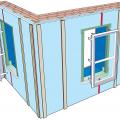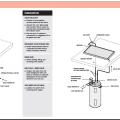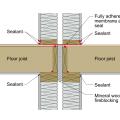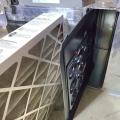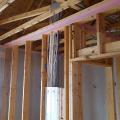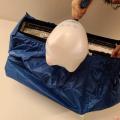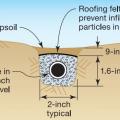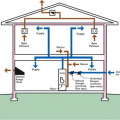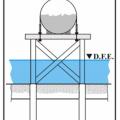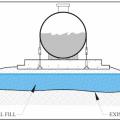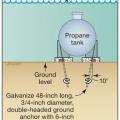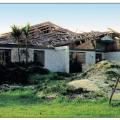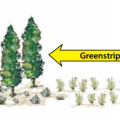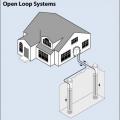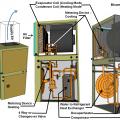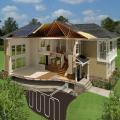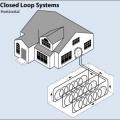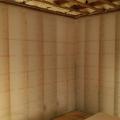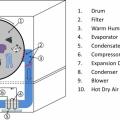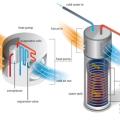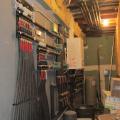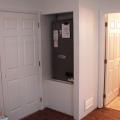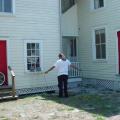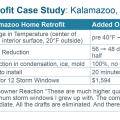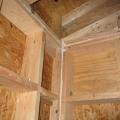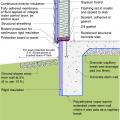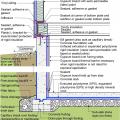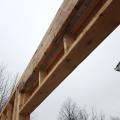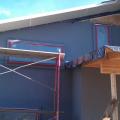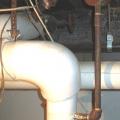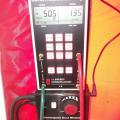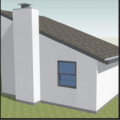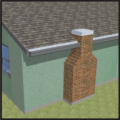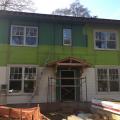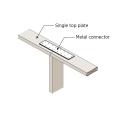Showing results 1 - 250 of 4973
A method for preventing waterproofing issues at the intersection of a concrete pier, concrete retaining wall, and concrete slab.
Airflow within drop-in ceiling assemblies is generally not a concern due to the limited vertical height. However, airflow within air gaps in walls is a concern due to the much larger vertical height.
An example of the water budget tool report for determining a home's landscaping irrigation needs.
DOE's Building Energy Codes Program tracks the status of state energy code adoption and state equivalency to various versions of the International Energy Conservation Code.
Example of the advanced framing technique, double-stud wall cavity, which will later be filled with blown insulation
Imery & Company built this custom for buyer home in the mixed-humid climate in Lilburn, GA, and certified it to DOE Zero Energy Ready Home specifications in 2018.
Impervious surfaces like patio slabs, sidewalks, and driveways that are within 10 feet of the home should slope away from the house.
Individual ventilation systems for each dwelling unit in a multifamily building will require large numbers of penetrations in exterior facades
Install mesh insect barrier along the bottom of the rain screen behind the exterior cladding of above-grade walls
Place plants at least 18 inches from the building's walls and foundation and direct irrigation water to spray away from the structure.
Right - Drywall is installed as an air barrier above the central hallway duct chase prior to installing the trunk ducts.
Right: dedicated tank connections for HPWH inlet and outlet provide hydraulic separation
Taped plywood provides an air barrier beneath the cork insulation installed on the exterior of this home.
The “perimeter cutoff and dewatering” approach can be used to control groundwater in cases where the building foundation is below the groundwater table.
These folding louvered porch doors provide effective shade from low-angle east and west sunlight and can open for views; the photovoltaic panels overhead allow in filtered natural light
These schematics illustrate temporary deployment locations for probes during the commissioning process; these probes connect to smartphone commissioning applications.
This central ventilation system uses an energy recovery ventilator to supply air to the corridor and exhaust air from the elevator shaft of a multifamily building
[bundle] design studio built this attached home in the marine climate in Bellingham, WA, and certified it to DOE Zero Energy Ready Home specifications in 2021.
[bundle] Design Studio built this custom for buyer home in the marine climate in Bellingham, WA, and certified it to DOE Zero Energy Ready Home specifications in 2021.
[bundle] design studio built this custom spec home in the marine climate in Bellingham, WA, and certified it to Zero Energy Ready Home in 2016.
2021 IECC Climate Zone 1A: Flat Roof, Unvented, 2x6 Wall, Monolithic Slab on Grade
2021 IECC Climate Zone 1A: Flat Roof, Unvented, 2x6 Wall, Monolithic Slab on Grade (with notes)
2021 IECC Climate Zone 2A: Flat Roof, Unvented, 2x6 Wall, Monolithic Slab on Grade
2021 IECC Climate Zone 2A: Flat Roof, Unvented, 2x6 Wall, Monolithic Slab on Grade (with notes)
2021 IECC Climate Zone 2A: Unvented Attic with Spray Foam at Roof Deck, 2x6 Wall-CMU Wall, Elevated Slab
2021 IECC Climate Zone 2B: Flat Roof, Unvented, 2x6 Wall, Monolithic Slab on Grade
2021 IECC Climate Zone 2B: Flat Roof, Unvented, 2x6 Wall, Monolithic Slab on Grade (with notes)
2021 IECC Climate Zone 3A: Vented Cathedral Ceiling, 2x6 Wall, Vented Crawl Space
2021 IECC Climate Zone 3A: Vented Cathedral Ceiling, 2x6 Wall, Vented Crawl Space (with notes)
2021 IECC Climate Zone 3B: Vented Cathedral Ceiling, 2x6 Wall, Vented Crawl Space
2021 IECC Climate Zone 3C: Vented Cathedral Ceiling, 2x6 Wall, Vented Crawl Space
2021 IECC Climate Zone 4A: Vented Cathedral Ceiling, 2x6 Wall, Slab on Grade (with notes)
2021 IECC Climate Zone 4A: Vented Cathedral Ceiling, 2x6 Wall, Vented Crawl Space
2021 IECC Climate Zone 4B: Vented Cathedral Ceiling, 2x6 Wall, Slab on Grade (with notes)
2021 IECC Climate Zone 4B: Vented Cathedral Ceiling, 2x6 Wall, Vented Crawl Space
2021 IECC Climate Zone 4C: Vented Attic, 2x4 Wall, Interior Insulated Basement (with notes)
2021 IECC Climate Zone 4C: Vented Attic, Exterior Double Wall, Interior Insulated Basement
2021 IECC Climate Zone 4C: Vented Attic, Exterior Double Wall, Interior Insulated Basement (with notes)
2021 IECC Climate Zone 4C: Vented Attic, ICF Wall, ICF Basement Foundation (with notes)
2021 IECC Climate Zone 4C: Vented Attic, Interior Double Wall, Interior Insulated Basement
2021 IECC Climate Zone 4C: Vented Attic, Strapped 2x6, Interior Insulated Basement
2021 IECC Climate Zone 4C: Vented Cathedral Ceiling, 2x6 Wall, Interior Insulated Basement
2021 IECC Climate Zone 4C: Vented Cathedral Ceiling, 2x6 Wall, Slab on grade (with notes)
2021 IECC Climate Zone 4C: Vented Over-Roof, Unvented Cathedral Ceiling, 2x6 Wall, Interior Insulated Basement
2021 IECC Climate Zone 5: Vented Attic, 2x4 Wall, Interior Insulated Basement (with notes)
2021 IECC Climate Zone 5: Vented Cathedral Ceiling, 2x6 Wall, Interior Insulated Basement
2021 IECC Climate Zone 5A: Vented Attic, Exterior Double Wall, Interior Insulated Basement
2021 IECC Climate Zone 5A: Vented Attic, Interior Double Wall, Interior Insulated Basement
2021 IECC Climate Zone 5A: Vented Attic, Strapped 2x6, Interior Insulated Basement
2021 IECC Climate Zone 5A: Vented Cathedral Ceiling, 2x6 Wall, Interior Insulated Basement
2021 IECC Climate Zone 5A: Vented Over Roof, Unvented Cathedral Ceiling, 2x6 Wall, Interior Insulated Basement
2021 IECC Climate Zone 5B: Vented Attic, Exterior Double Wall, Interior Insulated Basement
2021 IECC Climate Zone 5B: Vented Attic, Interior Double Wall, Interior Insulated Basement
2021 IECC Climate Zone 5B: Vented Attic, Strapped 2x6, Interior Insulated Basement
2021 IECC Climate Zone 5B: Vented Cathedral Ceiling, 2x6 Wall, Interior Insulated Basement
2021 IECC Climate Zone 5B: Vented Over Roof, Unvented Cathedral Ceiling, 2x6 Wall, Interior Insulated Basement
2021 IECC Climate Zone 5C: Vented Attic, Exterior Double Wall, Interior Insulated Basement
2021 IECC Climate Zone 5C: Vented Attic, Interior Double Wall, Interior Insulated Basement
2021 IECC Climate Zone 5C: Vented Attic, Strapped 2x6, Interior Insulated Basement
2021 IECC Climate Zone 5C: Vented Cathedral Ceiling, 2x6 Wall, Interior Insulated Basement
2021 IECC Climate Zone 5C: Vented Over Roof, Unvented Cathedral Ceiling, 2x6 Wall, Interior Insulated Basement
2021 IECC Climate Zone 6: Vented Cathedral ceiling, 2x6 Wall, interior Insulated Basement
2021 IECC Climate Zone 6: Vented Cathedral ceiling, 2x6 Wall, interior Insulated Basement (with notes)
2021 IECC Climate Zone 6A: Vented Attic, Exterior Double Wall, Interior Insulated Basement
2021 IECC Climate Zone 6A: Vented Attic, Strapped 2x6, Interior Insulated Basement
2021 IECC Climate Zone 6A: Vented Cathedral Ceiling, 2x6 Wall, Interior Insulated Basement
2021 IECC Climate Zone 6A: Vented Over-Roof, Unvented Cathedral Ceiling, 2x6 Wall, Interior Insulated Basement
2021 IECC Climate Zone 6A:Vented Attic, Interior Double Wall, Interior Insulated Basement
2021 IECC Climate Zone 6B: Vented Attic, Exterior Double Wall, Interior Insulated Basement
2021 IECC Climate Zone 6B: Vented Attic, Interior Double Wall, Interior Insulated Basement
2021 IECC Climate Zone 6B: Vented Attic, Strapped 2x6, Interior Insulated Basement
2021 IECC Climate Zone 6B: Vented Cathedral Ceiling, 2x6 Wall, Interior Insulated Basement
2021 IECC Climate Zone 6B: Vented Over-Roof, Unvented Cathedral Ceiling, 2x6 Wall, Interior Insulated Basement
2021 IECC Climate Zone 7 and 8: Vented Cathedral Ceiling, 2x6 Wall, Interior Insulated Basement (with notes)
2021 IECC Climate Zones 7 and 8: Vented Attic, 2x4 Wall, Interior Insulated Basement
2021 IECC Climate Zones 7 and 8: Vented Attic, Exterior Double Wall, Interior Insulated Basement
2021 IECC Climate Zones 7 and 8: Vented Attic, ICF Wall, ICF Basement Foundation
2021 IECC Climate Zones 7 and 8: Vented Attic, Interior Double Wall, Interior Insulated Basement
2021 IECC Climate Zones 7 and 8: Vented Attic, Strapped 2x6, Interior Insulated Basement
2021 IECC Climate Zones 7 and 8: Vented Cathedral Ceiling, 2x6 Wall, Interior Insulated Basement
2021 IECC Climate Zones 7 and 8: Vented Cathedral Ceiling, 2x6 Wall, Slab on Grade
2021 IECC Climate Zones 7 and 8: Vented Over-Roof, Unvented Cathedral Ceiling, 2x6 Wall, Interior Insulated Basement
2021 IECC Window Detail: Double Wall Framed with Plywood or OSB Sheathing, a WRB, and Siding (Wood, Fiber Cement, Aluminum, or Vinyl)
2021 IECC Window Detail: Framed Wall with a WRB, Rigid Insulation, and Siding (Wood, Fiber Cement, Aluminum or Vinyl) or Stucco
2021 IECC Window Detail: Framed Wall with Plywood or OSB Sheathing, a WRB, and Siding (Wood, Fiber Cement, Aluminum or Vinyl, or Stucco)
2021 IECC Window Detail: Framed Wall with Plywood or OSB Sheathing, a WRB, Thick Rigid Insulation, and Siding (Wood, Fiber Cement, Aluminum or Vinyl)
2021 IECC Window Detail: Framed Wall with Rigid Insulation and Siding (Wood, Fiber Cement, Aluminum or Vinyl)
2021 IECC Window Detail: Framed Wall with Thick Rigid Insulation and Siding (Wood, Fiber Cement, Aluminum or Vinyl)
2021 IECC Window Detail: Strapped 2x6 Framed Wall with Plywood or OSB Sheathing, a WRB and Siding (Wood, Fiber Cement, Aluminum or Vinyl)
A 1- and ½-story home with a room located in the attic and the thermal boundary located at either a) the walls and ceiling of the attic room with small vented attic spaces or b) the roof line for an unvented attic
A 5,000- 6,000 Btu/hr air conditioner drawing about 500 watts can be installed in one window of a designated cool room (it is important that the installation is insulated and well-sealed
A battery storage system can provide reliable back-up power during a grid power outage
A battery storage system's capacity is shown using three different usage approaches.
A blower door is installed in a doorway and is ready for testing
A blower door is used to test air leakage in this multifamily building during construction
A boiler system can be set up with primary and secondary loops to supply hot water for multiple uses
A braced water heater is attached to a raised platform that is anchored to the floor
A builder, energy efficiency consultant, and crew supervisor inspect a spray foam installation.
A Category I induced draft boiler uses an induced draft fan to pull air through the combustion chamber and to the flue
A caulk gun is a simple but power tool for sealing narrow cracks between framing and around penetrations.
A central fan-integrated supply system uses a fresh air intake ducted to the home's central furnace or air handler unit to supply fresh air throughout the home
A central heat pump water heating system with a parallel loop tank temperature maintenance configuration uses a multi pass heat pump water heater to provide all the heat for hot water circulation temperature maintenance.
A central heat pump water heating system with a parallel loop tank temperature maintenance configuration uses a multi-pass heat pump water heater to provide all the heat for hot water circulation temperature maintenance
A central heat pump water heating system with a temperature maintenance swing tank configuration uses the water from the primary storage tank to provide most of the heat for hot water circulation temperature maintenance
A central rooftop fan supplies outdoor air to all floors of a multistory multifamily building, pressurizing the corridors and providing make-up air for the elevator shaft, which is depressurized by an exhaust fan.
A central rooftop fan supplies preconditioned outdoor air to every floor of a multistory multifamily building, pressurizing the corridors and providing make-up air for the elevator shaft, which is depressurized by an exhaust fan.
A coated OSB product with taped seams covers the walls to serve as both sheathing and weather-resistant barrier.
A combination of brackets and self-locking drawers. Drawer closures should be used to protect the home during seismic events.
A common method of addressing significant groundwater leakage in the foundation is to line the entire foundation assembly, including the slab, with a drainage layer.
A common method of addressing significant groundwater leakage in the foundation is to line the interior perimeter of the foundation with a drainage layer.
A comparison of a dirty furnace filter on left and clean filter on right. Dirty filters block airflow and make the furnace or air handler work harder.
A concrete slab floor can be elevated above local grade as a strategy to prevent flood damage.
A concrete slab-on-grade foundation with exterior insulation, which can be elevated above the local grade as a flood-prevention strategy.
A cone or disc of plastic or sheet metal can be installed on pipes and downspouts to prevent rodents from climbing up the outside and gaining access to the roof
A constant airflow regulator is a modulating orifice that automatically regulates airflows in duct systems to constant levels
A constant airflow regulator is fitted into the neck of the supply duct to control air flow to deliver the design airflow regardless of pressure variations
A continuous bead of sealant is installed to air seal along the top and bottom plates at all exterior walls and intersecting interior walls as well as around windows in exterior walls
A continuous drainage mat rainscreen made from vacuum-molded plastic provides uniform support for the siding and allows moisture to flow horizontally and diagonally in addition to vertically.
A continuous layer of polyethylene covers the crawlspace floor and is attached to the wall with wood nailing strips
A continuous load path uses structural connections to transfer horizontal and vertical loads from the roof to the foundation to help keep the building intact in high-wind and seismic events
A continuum of green (soft) to grey (hard) shoreline stabilization techniques used to mitigate the effects of erosion
A cool roof utilizes materials with high solar reflectance and thermal emittance to reflect solar energy and reduce heat gain to the home
A cool room should have low enough heat gains to be easily cooled by a small single-zone cooling system such as a mini-split or a window air-conditioner as shown here
A Corsi-Rosenthal Box is a highly effective DIY air cleaner made of easy to obtain materials such as HVAC filters, a box fan, cardboard, and tape
A cross-section of a vinyl-framed window showing metal reinforcement which helps support the window and prevent collapse if exposed to heat from a fire.
A deck or other attached structure located at the top of a slope with vegetation underneath is at high risk of ignition during a wildfire
A demand plumbing layout uses a recirculation pump to speed delivery of hot water to plumbing fixtures.
A dense concentration of buildings and pavement can create the Urban Heat Island Effect, where local temperatures can be several degrees higher than the surrounding areas
A detached garage offers more space to place solar panels with likely fewer roof penetrations and more options for roof pitch and orientation.
A dimpled plastic water barrier protects the insulated concrete form basement walls and carries any ground water down the walls to the footing drain to minimize the opportunity for water intrusion and frost heave.
A dimpled rain mat and perforated drain pipe provide drainage around the basement foundation.
A direct-vent sealed-combustion fireplace takes its combustion air directly from outside through a dedicated air inlet and vents combustion products directly outside
A direct-vent sealed-combustion furnace has dedicated pipes for combustion air and exhaust
A dormer with an openable window (not shown) can provide access to the roof if flood waters rise too high and too quickly; the dormer should be properly insulated, flashed, and air sealed
A drainage plane is created behind lap siding by installing furring strips on the exterior walls over house wrap which is overlapped and taped at all seams to serve as an air and water barrier.
A dry hydrant is a pipe a homeowner can have installed in a natural water source on their rural property to provide easy access to the water by firefighting crews.
A drywell, shown here used for downspout catchment, can also be used to receive water from a French drain.
A duct leakage test is performed on a ducted heat pump system using a duct tester (blower fan) and a digital manometer.
A ducted central return brings air from central return registers back to the air handler through insulated, air-sealed ducts
A ducted minisplit heat pump is hidden in the ceiling of this centrally located room with short duct runs to the registers located on each wall of the room.
A ductless heat pump is hidden behind a wall outcropping above the hallway ceiling.
A FIRM will identify specific SFHAs (colored and hatched areas) and localized BFEs (wavy black lines)
A flanged window unit is installed with straps that fasten to the interior surfaces of the plywood extension box; furring strips on each side of the window will be attached after the flanged window is installed and flashed
A flat plate solar hot water system heat potable water in a glass covered collector that sits on the roof.
A flexible membrane was installed across the floor joists to prevent air movement between the floor joists in this multifamily 1-hr partition wall assembly
A floor cavity between the first and second floor can provide a conditioned space for HVAC ducts if the rim joists are insulated and air sealed, if sufficient space is available, and if open-web floor joists are used
A flow grid is inserted into the filter grille/slot to directly measure airflow.
A foam gasket is installed along the top plates before installing drywall as an air-sealing step to help achieve a quieter, draft-free home.
A foaming cleaner is used to clean the coils inside this ductless indoor unit; a mini-split bib surrounds the unit to contain overspray and drips
A foaming sprayer and mini-split bib are required to properly clean this ductless wall-mounted indoor unit
A French drain contains a perforated drain pipe wrapped in rock and landscape fabric.
A fresh air inlet is ducted to the return side of the home’s central air handler; a motorized damper and electronic controls help balance the flow of fresh incoming air with controlled exhaust to meet ventilation requirements
A fuel tank elevated above the design flood elevation on a platform in a high velocity flow area.
A fuel tank is strapped onto a concrete slab at the top of compacted fill above the DFE.
A fuel tank should be anchored with ground anchors designed for site conditions to maintain secure connection to its base in a flood or earthquake
A gable end failure due to improper bracing caused collapse of most of the trusses on this roof under hurricane force wind conditions.
A green strip is a type of fuel break planted with less flammable vegetation; e.g., crested wheatgrass.
A ground source heat pump with an open-loop piping system using vertical injection and recharge
A ground-source heat pump has the same components as a standard air-to-air heat pump except that the liquid-to-refrigerant heat exchanger coil is located inside rather than outside
A ground-source heat pump used a fluid flowing through pipe loops to draw heat from or discharge heat the ground to heat or cool the indoor space.
A ground-source heat pump with a closed-loop horizontal “Slinky™ “piping arrangement
A gut rehab that includes drywall removal provides the opportunity to thoroughly insulate the walls.
A heat pump clothes dryer is a type of condensing clothes dryer that uses heat pump technology to efficiently dry clothes
A heat pump water heater has a small heat pump located on top of the tank which extracts heat from the surrounding air to create hot water.
A high-efficiency gas boiler provides hot water to the faucets, to radiant heating loops in the basement floor, and to a hydro-coil for a central air heating system.
A high-efficiency heat pump is installed in a closet within this home’s conditioned space.
A home is tested at two points for enclosure air leakage
A Kalamazoo homeowner reduced wintertime chill, condensation, and snowblower noise by installing high-performance interior storm windows
A large bead of caulk is installed on the interior surface of the wall top and bottom plates to provide an air sealing gasket between the framing and the dry wall.
A layer of pea gravel or crushed stone, 4 inches thick and sloped 5%, provides a pest-resistant ground break around the perimeter of a slab foundation
A layer of pea gravel or crushed stone, 4 inches thick and sloped 5%, provides a pest-resistant ground break around the perimeter of a basement foundation
A layer of rigid foam is sandwiched between two layers of 2x8 lumber in this insulated header over a window.
A liquid-applied water barrier covers the walls, serving as a drainage plane, air and vapor barrier, and secondary window flashing beneath the rigid foam that will be installed next.
A low-sloped shed roof with the thermal boundary located at either a) the flat ceiling with a vented attic or b) the roof line for an unvented attic
A manometer is used to measure pressure differentials between indoors and outdoors when testing whole-house air leakage.
A masonry chimney is reconstructed to withstand seismic forces by adding an insert to the existing firebox
A masonry chimney is reconstructed to withstand seismic forces by completely retrofitting the firebox and chimney using light-frame construction on the top of the foundation
A masonry chimney is reconstructed to withstand seismic forces by maintaining the current firebox but replacing the chimney section with a metal flue and light-weight chimney enclosure.
A masonry chimney is shortened and capped at roof level to reduce its chances of detaching in high winds or earthquakes; the fireplace can no longer be used.
A mesh plastic rainscreen product separates the coated OSB from the siding, providing a drainage space and ventilation gap.
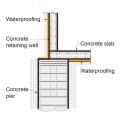
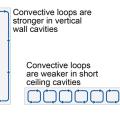

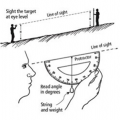


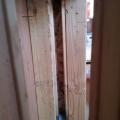

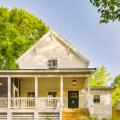
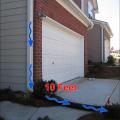
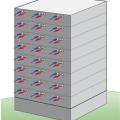
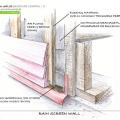

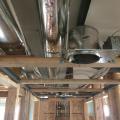
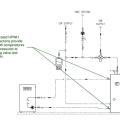
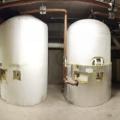
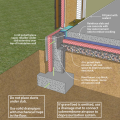
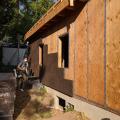
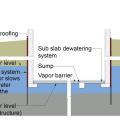
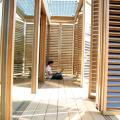
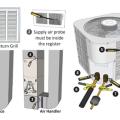
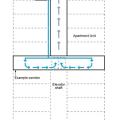
![[bundle] design studio built this attached home in the marine climate in Bellingham, WA, and certified it to DOE Zero Energy Ready Home specifications in 2021.](/sites/default/files/styles/image_gallery/public/images/2021-Bundle-Flc-1-Aerial-Front-Elevation-Roof.jpg?h=9b6f7c84&itok=JcYZmkH8)
![[bundle] Design Studio built this custom for buyer home in the marine climate in Bellingham, WA, and certified it to DOE Zero Energy Ready Home specifications in 2021.](/sites/default/files/styles/image_gallery/public/images/2021-Bundle-Mid-1-Front-Elevation-Yard.jpg?h=251cce06&itok=AM9jb0yD)
![[bundle] design studio built this custom spec home in the marine climate in Bellingham, WA, and certified it to Zero Energy Ready Home in 2016.](/sites/default/files/styles/image_gallery/public/images/2016_Bundle_Birch-1-Front.jpg?h=654f81f0&itok=pd9jy-eb)
